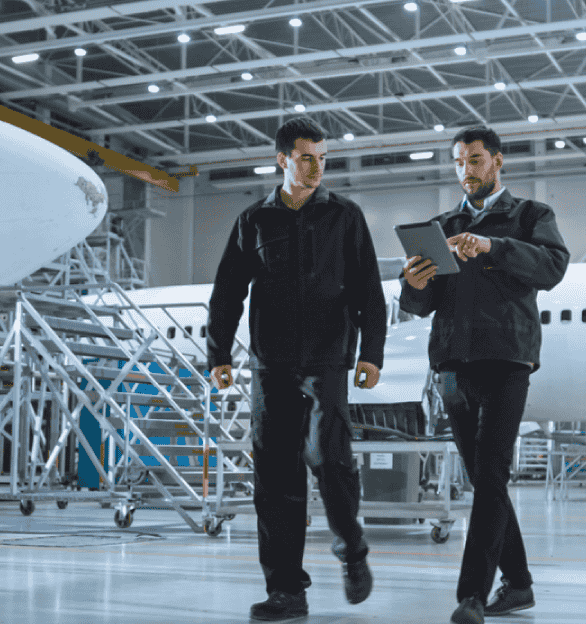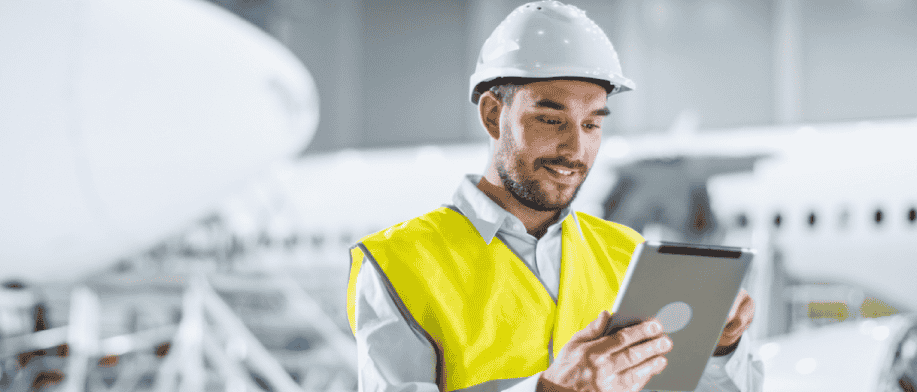
Aircraft Maintanance Engineering
Unlock Opportunities in Aviation Maintenance at Hadron Aviation
Our 18-month Aircraft Maintenance Engineering (AME) program is available for candidates sponsored by the industry or those with at least 1 year of work experience in a relevant sector or profile.
Aircraft Maintenance Engineer (AME), also referred to as Licensed Aircraft Maintenance Engineer (LAME or L-AME), is an individual tasked with conducting Aircraft Maintenance and Certifying Aircraft Airworthiness. This license is issued by Directorate General of Civil Aviation (DGCA) Govt. of India & it is globally recognized by the International Civil Aviation Organization (ICAO). The AME course offers comprehensive training in Aircraft Maintenance, Repair, and Troubleshooting. Prior approval from a licensed AME is necessary before an aircraft can take off to ensure safety and compliance with aviation regulations. AMEs ensure aircraft are in a fit-to-fly condition, thereby contributing to aviation safety. The Aircraft Maintenance field offers significant opportunities in India and abroad, as airlines, maintenance, repair, and overhaul (MRO) facilities, and flying institutes continuously seek skilled professionals to maintain their fleets.
Objective of 18 Month AME Program
Crafting Tomorrow's Aviation Experts Today
Embark on a transformative journey with Hadron Aviation's 18-month Aircraft Maintenance Engineer (AME) program. Designed to shape industry-ready professionals, this comprehensive course equips candidates with the knowledge, skills, and practical experience needed to excel in the dynamic field of aircraft maintenance. From mastering intricate systems to ensuring safety compliance, our program focuses on cultivating expertise and fostering a deep understanding of aviation fundamentals. Prepare to soar to new heights as you embark on this immersive learning experience tailored for tomorrow's aviation leaders. The objective is to prepare working professionals to excel in their roles and contribute effectively to the safe and efficient operation of aircraft.
Skills Upgradation
Providing already working professionals with advanced knowledge and techniques in aircraft maintenance to enhance their skill set
Career Growth
Equipping professionals with the necessary qualifications and expertise to progress in their careers within the aviation industry, potentially leading to higher positions and responsibilities.
Specialization
Offering specialized training in specific areas of aircraft maintenance to meet industry demands and address evolving technologies.
Regulatory Compliance
Ensuring that participants are knowledgeable about and compliant with aviation regulations and safety standards relevant to their field.
Practical Experience
Providing hands-on experience and exposure to real-world scenarios to develop practical problem-solving skills and confidence in handling aircraft maintenance tasks.
Types of AME Licenses
Category A
Category “A’ licence engineer can do layover inspection & minor maintenance tasks of aircraft. Its sub-categories are as follows:
Module 3 – Electrical Fundamentals
Module 5 – Digital Techniques/Electronic Instrument Systems
Module 6 – Materials and Hardware
Module 7A – Maintenance Practices
Module 8 – Basic Aerodynamics
Module 9A – Human Factors
Module 10 – Aviation Legislation
Module 11A – Turbine Aeroplane Aerodynamics, Structures and Systems
Module 15A – Gas Turbine Engine
Module 17A – Propeller
Module 3 – Electrical Fundamentals
Module 5 – Digital Techniques/Electronic Instrument Systems
Module 6 – Materials and Hardware
Module 7A – Maintenance Practices
Module 8 – Basic Aerodynamics
Module 9A – Human Factors
Module 10 – Aviation Legislation
Module 11B – Piston Aeroplane Aerodynamics, Structures and Systems.
Module 16 – Piston Engine
Module 17A – Propeller
Module 3 – Electrical Fundamentals
Module 5 – Digital Techniques/Electronic Instrument Systems
Module 6 – Materials and Hardware
Module 7A – Maintenance Practices
Module 9A – Human Factors
Module 10 – Aviation Legislation
Module 12 – Helicopter Aerodynamics, Structures and Systems
Module 15 – Gas Turbine Engine
Module 3 – Electrical Fundamentals
Module 5 – Digital Techniques/Electronic Instrument Systems
Module 6 – Materials and Hardware
Module 7A – Maintenance Practices
Module 9A – Human Factors
Module 10 – Aviation Legislation
Module 12 – Helicopter Aerodynamics, Structures and Systems
Module 16 – Piston Engine
Category B
Category ‘B’ Licence holders can do all types of minor & major Maintenance tasks in aircraft. Category further has two sub categories B1.1 (Mechanical Stream) & B2 (Avionics Stream).Category B1- This includes all kind of minor & major maintenance of Airframe & Engine system which covers Mechanical stream.it has further below mentioned sub-categories.
Module 3 – Electrical Fundamentals
Module 4 – Electronic Fundamentals
Module 5 – Digital Techniques/Electronic Instrument Systems
Module 6 – Materials and Hardware
Module 7A – Maintenance Practices
Module 8 – Basic Aerodynamics
Module 9A – Human Factors
Module 10 – Aviation Legislation
Module 11 – Turbine Aeroplane Aerodynamics, Structures and Systems
Module 15 – Gas Turbine Engine
Module 17 – Propeller
Module 3 – Electrical Fundamentals
Module 4 – Electronic Fundamentals
Module 5 – Digital Techniques/Electronic Instrument Systems
Module 6 – Materials and Hardware
Module 7A – Maintenance Practices
Module 8 – Basic Aerodynamics
Module 9A – Human Factors
Module 10 – Aviation Legislation
Module 11 – Turbine Aeroplane Aerodynamics, Structures and Systems
Module 16 – Piston Engine
Module 17 – Propeller
Module 3 – Electrical Fundamentals
Module 4 – Electronic Fundamentals
Module 5 – Digital Techniques/Electronic Instrument Systems
Module 6 – Materials and Hardware
Module 7A – Maintenance Practices
Module 8 – Basic Aerodynamics
Module 9A – Human Factors
Module 10 – Aviation Legislation
Module 11 – Turbine Aeroplane Aerodynamics, Structures and Systems
Module 16 – Piston Engine
Module 17 – Propeller
Module 3 – Electrical Fundamentals
Module 4 – Electronic Fundamentals
Module 5 – Digital Techniques/Electronic Instrument Systems
Module 6 – Materials and Hardware
Module 7A – Maintenance Practices
Module 8 – Basic Aerodynamics
Module 9A – Human Factors
Module 10 – Aviation Legislation
Module 12 – Helicopter Aerodynamics, Structures and Systems
Module 16 – Piston Engine
Module 3 – Electrical Fundamentals
Module 4 – Electronic Fundamentals
Module 5 – Digital Techniques/Electronic Instrument Systems
Module 6 – Materials and Hardware
Module 7A – Maintenance Practices
Module 8 – Basic Aerodynamics
Module 9A – Human Factors
Module 10 – Aviation Legislation
Module 13 – Aircraft Aerodynamics, Structures and Systems
Module 14 – Propulsion

Eligibility
- 12th Standard or Equivalent with (Physics, Chemistry, and Mathematics) or Diploma in 10+3) Mechanical, Electronics, Electrical and Aeronautical Engineering.
- Medical Fitness: Mandatory Physical Fitness Certificate from a DGCA Approved Medical Examiner. No Colour blindness certificate from DGCA Approved Ophthalmologist
- Age Criteria: Minimum Age 17 Years
- Candidates should be at least 18 years old at the time of admission. There is no upper age limit for pursuing Aircraft Maintenance Engineering
ADVANTAGES @ HADRON AVIATION
- Cost Effective Training Program
- Tech Enabled classrooms with Audio-visual facility
- Most Advanced Simulators
- Collaboration with various renowned Airlines, MRO’s, Flying School across India for practical training
- Extensive library stocked with reference books, magazines & periodicals
Employment Opportunities
AMEs can find employment with Airlines, Aircraft Manufacturers, Maintenance, Repair and Overhaul (MRO) Organizations, Flying Clubs, Government Aviation Departments, and other Aviation-related Companies. The career scope for Aircraft Maintenance Engineers is promising, offering a dynamic and rewarding career path for individuals passionate about aviation and aircraft maintenance, while working on different types of aircraft AMEs gain valuable experience and knowledge, enhancing their versatility and adaptability in the field. Specializing in specific areas enables AMEs to become experts in their chosen field, opening up avenues for career advancement and higher salaries.
Global Opportunities
The global nature of the aviation industry offers AMEs to work in various countries, experiencing different cultures and environments while contributing to the growth of aviation worldwide. Staying abreast of technological advancements and regulatory changes through continuous learning ensures that AMEs remain competent and relevant in their profession throughout their careers. The essential role of aircraft maintenance ensures steady demand for AMEs, providing job security even during economic downturns. The specialized skills and expertise of AMEs command competitive salaries, with opportunities for additional income through overtime and bonuses. The dynamic work environments in which AMEs operate offer unique experiences and challenges, fostering personal and professional growth.
Placement Track
OUR STUDENTS ARE PLACED in various Scheduled, Non-scheduled and Cargo Services, MRO Organizations, Aircraft Parts Manufacturing Companies, Flight Training Organizations, Aviation Training Centres Aircraft Manufacturing Companies, Aircraft Parts Manufacturing Companies.
